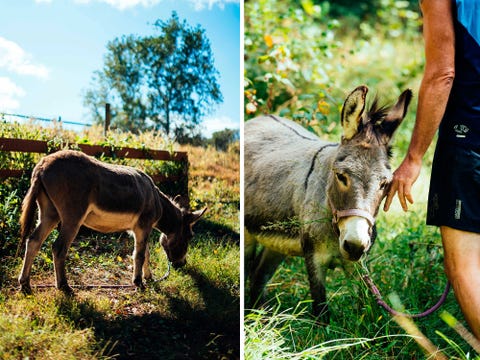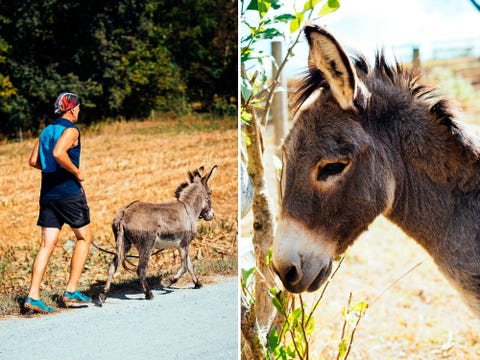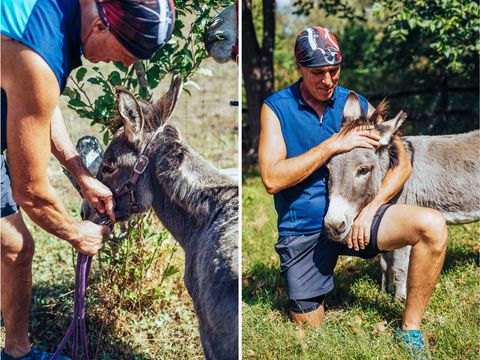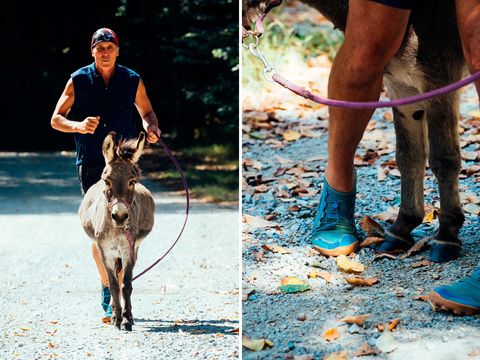After a lifetime of abuse and neglect, Sherman’s future looked bleak—until author Christopher McDougall found him a purpose.
I’d been waiting for Wes for more than an hour, and now, before he even came to a stop, the look in his eye warned me to brace myself.
“He’s in rough shape,” Wes said as he got out of the truck. “Rougher than I thought.” I’ve known Wes for more than 10 years, nearly from the day my wife and I first uprooted ourselves from Philadelphia to live on this small farm in Pennsylvania Amish country, and I’d never seen him so grim. Together, we walked behind the pickup and pulled open the trailer doors.
Suddenly, Tanya clicked off her shears and turned to face me.
“Look,” she said. “If he makes it, you can’t just stick a ribbon on his tail and leave him standing in a field like Eeyore. He’s been abused and abandoned, and that can make an animal sick with despair. You need to give this animal a purpose. You need to find him a job.”
A job? What was I going to do with a donkey, prospect for gold? Pioneer westward? But before I even asked what she meant, I got an idea. If Sherman found his way back to life, maybe I had something for him that was even better than a job: a wild adventure that the two of us could tackle together, side by side.
“That’s your idea?” Tanya snorted. “A burro race?”
She began squinting as I told this story, squeezing her eyes as if trying not to look at me. “So how far would he have to run?” she asked.
“The World Championship has two distances—”
“The World Championship.” She was smirking now, as if she’d just caught the punch line. “Not just a race. A World Championship.”

Colorado pack-burro racing is a throwback to the Gold Rush days in Leadville, Colorado, when prospectors would hit pay dirt, heave their gear onto their burros, and hightail it to town to file their claims. In 1949, an epic challenge was thrown down: Anyone foolish enough to try was invited to a 23-mile, all-comers burro race stretching from the Silver Dollar Saloon, up and over a 13,500-foot mountain, and back down the far side to the Prunes memorial in Fairplay, erected in honor of a donkey who wandered around Fairplay for years as the town’s shared pet.
Until 1980, women were banned from any Olympic track event longer than 800 meters. Meanwhile, in Boston, Running While Female was literally a crime: Any woman who dared attempt the Boston Marathon in the 1960s was subject to arrest by the cops or, if your dad was in charge, a beating. “If that girl were my daughter, I would spank her,” race director Will Cloney famously snarled after Kathrine Switzer finagled her way onto the course in 1967.

But in Leadville, the hardrock miners saw things a little differently. “Out West, we’ve always known that women were cut from the same leather as men,” said Curtis Imrie, the legendary burro racer who was happy to talk about the many times he’d been smoked by women like Barb Dolan and Karen Thorpe. “Burro racing has none of that nonsense you have back East about ‘protecting’ women.”
Looking back, it’s kind of insane that in Boston, grouchy old men with cigars and overcoats would keep declaring until 1972 that women were too dainty to run their marathon, while in Colorado, the “ladies” had been tearing up a far more grueling challenge for 20 years. Boston likes to boast that it’s America’s oldest marathon, but that’s true for only some Americans. For the other half of the population, the ones who were outlawed for decades from even entering, it’s as if the race didn’t exist. So for all Americans, men and women alike, our oldest marathon is the one that’s always been open to everyone. It’s not going to cost you a fortune, and you don’t have to qualify. All you have to do is show up, borrow a donkey, and get ready for battle.
“So when is this race?” Tanya asked.
“Next July,” I said. “Little less than a year.” Tanya pursed her lips, rocking her head back and forth noncommittally. Tanya wasn’t on board yet with my burro race idea, not by a long shot, but I could tell she was intrigued by the intellectual challenge. For a skilled trainer like her, it was like tackling a math problem for NASA; she wasn’t promising she could put a man on Mars, but she wanted to at least see if she could crack the equation.

“How far will he have to run?”
“Twenty-nine miles,” I said. “Fifteen for the short course.”
“Fifteen. Is short.” Tanya rolled her eyes. “Well, I’m the one who told you to find him a job. But it won’t be easy. Sherman can come up with a million ways to make your life a living hell.”
Tanya and I needed some help, and I had an idea where to look. It was time to call in Vella Shpringa—the world’s only Amish running club.
Our neighborhood in Lancaster County is home to America’s largest community of Old Order Amish, and among those horse-and-buggy drivers is a much smaller sub-group of Amish ultrarunners. Vella Shpringa means “Let’s all run” in Pennsylvania Dutch, and it began as a wholesome way for young Amish singles to get together on Sunday afternoons. The club soon created two magnificent traditions: They adopted an all for one, one for all motto—“The joy of running in community”—and launched the Full Moon Run, a monthly ramble under the stars hosted by various Amish families.

Before long, these Amish amateurs were getting fast. Everything the Amish have learned over the past 300 years about how to rely on their own bodies, the Vella Shpringa gang has applied to running. One Amish runner sliced a full hour off his marathon best in the course of a year, improving from 3:59 to a sizzling 2:54. Another wanted to see if a tall, muscular farmer like him could break five minutes in the mile and three hours in a marathon; within a year, he’d nailed both. As a six-man team, the Amish runners have won three Ragnar Relays covering distances from 128 to 200 miles. Leroy Stoltzfus was even featured in Ripley’s Believe It or Not! when he was spotted near the front of the pack in the Harrisburg Marathon in his long pants and suspenders, while Liz King has several times shown up at the starting line of a 10K in her full-length Amish dress and apron and outrun every other woman in the field.
Two months after Sherman arrived, I volunteered to host the Full Moon Run at our house. The Amish runners not only are strong and fast, but they’ve also been training animals since childhood. Just by luck, I might be living next to an undiscovered talent pool of expert burro racers: Where else are you going to find master horsemen with Boston Marathon speed?
“Is that the famous Sherman?” someone called from the darkness.
A van door slammed, and out stepped Jake Beiler, one of Vella Shpringa’s unofficial group leaders. Jake is tall and slender, but strong as a grizzly (one year at the finish of the Bird-in-Hand Half Marathon, Jake nearly single-handedly dunked me headfirst in the water barrel to cool off). I was holding Sherman’s rope, while nearby, Tanya was saddling Flower, her big riding donkey. Jake saw the donkeys were nervous and immediately took command. He switched off his headlamp and kept his hands low, approaching slowly. He moved his head around until he caught Sherman’s eye, locking gaze to let Sherman know he wasn’t in any danger.
“So this is our new friend,” Jake said, his voice low and reassuring. Sherman eyed him warily, but held still when Jake stroked his head and scratched him under the jaw. Around us, vans and pickup trucks continued to arrive, filling the driveway and squeezing into rows across the lawn in front of the house. The murmur of voices grew louder, a stew of English and Pennsylvania Dutch, as runners who hadn’t seen each other since the last full moon greeted each other and loosened up.

“Okay,” I told Tanya. “Let’s see how far we get.”
I unknotted Sherman’s rope and yanked it free from the gate. I turned to make sure Flower and Tanya were set, while Sherman began trotting down the driveway—
And kept on trotting.
As soon as he realized he could outrun the commotion behind him, Sherman was off. I watched him go, so impressed by his speed and initiative that it took a few beats before I realized the rope was about to jerk out of my hand as Sherman disappeared into the dark. I sprinted after the fugitive, while Tanya swung herself onto Flower and joined the pursuit. When I caught up with Sherm, he didn’t seem to be escaping; he was clip-clopping happily along like a thoroughbred on parade. I bent down and grabbed the rope but he never broke stride, cruising at a crisp jog.
“What’s he up to?” I asked Tanya.
“Beats me,” she said. She held Flower back to see if Sherman would slow down, but Sherman seemed oblivious. After about a quarter mile, we hit a long grinder of an uphill slope and Sherman didn’t hesitate; he shifted into climbing gear and streamed along so smoothly, I was gasping to keep up. “Holy crap,” I panted. “What’s gotten into him?”



